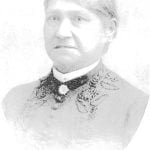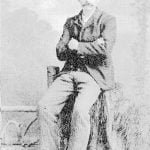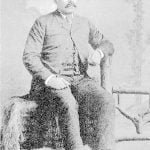By Henry B. Carrington
The retirement of the Indian westward within the United States has been qualified by two historical factors. The first grew out of the unlimited and conflicting sweep of British land grants, which involved subsequent conflicts of jurisdiction and corresponding compromises. The second was incidental’ to the passage of the ordinance of July 13, 1787, which organized the Northwest Territory. The first, especially in the adjustment of the claims of Massachusetts and New York to the same lands, dealt with Indian titles and rights, which neither party could wholly ignore. The white men had overlapped and practically surrounded certain internal nations. The United States followed the British precedent, recognizing the independent sovereignty of the Five Nations 1 in New York, and the rival states of Massachusetts and New York made their adjustments upon the same general basis.
Unlike their less fortunate countrymen in the southern states, the Five Nations inherited titles, which they fully maintained in spite of French invasion, compelling Great Britain to honor those titles in her settlement of issues with France. The French claim of discovery was not supplemented by one of conquest. The Iroquois confederacy successfully defended its ancestral homes against both Indian and civilized invaders, even before Plymouth and Yorktown were colonized or Hollanders occupied Manhattan Island. At the establishment of the American Republic the Five Nations were still too strong to be ruthlessly forced out of their surroundings, and the sentiment of the American people, supported by President Washington, completely suppressed any demonstration in that direction. The campaign of General Sullivan was based upon hostile invasion by the Indians and its settlement was treated as the end of a necessary war with contiguous states.
The ordinance of July 13, 1787, dealt with the Indian upon the border, whose hunting range had no limit, and whose home jurisdiction had no distinctive definition.
The distinction between the early status of the New York tribes and that of the western tribes is an important’ one in applying the facts obtained for the Eleventh Census of the United States to the solution of the problem in future dealings with the Six Nations.
The Indians of New York, early recognized as an independent body politic, too strong to be despised and to be conciliated as allies against other enemies, have been comparatively undisturbed by modern progress, which must inevitably resolve all purely tribal relations into common citizenship. The pressure from without has, in the main, been that of example and ideas rather than that of force. The reduction of their landed possessions and the modification of their governmental forms and social usages have been matters of negotiation, treaty, and friendly adjustment. The grant by King James I of England to the Plymouth colony, afterward known as Massachusetts, from the Indian tribe of that name, and the grant of Charles II to the Duke of York covered in part the same lands, involving questions similar to those which attended Virginia land grants and all others which extended westward to the Pacific ocean at a time when the geographical status of lands “westward” had no clear description.
A brief reference to the substantial settlement of this and other matters affecting the New York tribes is all that is needed in this connection. The numerous national treaties and acts of Congress and other treaties between the state of New York and the Six Nations, which are matters of public record, have been compiled and published by the state of New York in a volume entitled Report of special committee appointed by the assembly of 1888 to investigate the Indian problem of the state. The documents occupy 320 pages, octavo size. Additional printed matter of 804 pages embodies the testimony taken by a special commission in prosecuting their inquiries, and an appendix to the volume cites statutes and treaties, which have historic relation to the subject matter.
The state of New York has not been indifferent to the welfare of the Indian nor reluctant to encourage by legislative sanction his efforts to initiate civilized forms of government and modern methods of internal economy in his administration of home affairs, as was shown in the case of the Allegany and Cattaraugus Senecas. Of the statutes cited in the volume referred to 3 relate particularly to the Oneidas, 9 to the Tuscaroras, 10 to the Shinnecock of Long Island, 13 to the St. Regis (successors of the Mohawks), 21 to the Onondagas, 14 to the Tonawanda Senecas, and 37 to the Seneca Nation, as incorporated by statute, which embraces the Indians of the Allegany and Cattaraugus reservations proper.
These acts, eleemosynary, educational, and general, touch nearly every phase of state supervision and support which does not conflict with the quasi independence of the tribes under original treaties and supplemental agreements in harmony therewith.
Antecedents of The Six Nations
It is impossible to justly apply the tests of today without deference to the antecedents of this people owl that course of history which has perpetuated their independence while nearly all their contemporary tribes have diminished or disappeared. The advent of the white man in the colonization of the Atlantic coast was at a time when the Iroquois confederacy of the Mohawk, Oneida, Onondaga, Cayuga, and Seneca Nations had practically mastered the Algonquin Indians, which, in Canada, New England and the middle colonies, and the west, had long girdled the New York tribes as a belt of fire. Unlike the Algonquins, whose tribes had nothing to bind them together, but certain similar peculiarities of dialect and jealousy of the Five Nations, the Iroquois (the Mohawks, Oneidas, Onondagas, Cayugas, and Senecas) had a constitutional bond of union.
The traditions of the formation of this league are very old, systematic, and carefully preserved. The league was called Ko-ni-shi-o-ni, the “cabin builders” or the “long house“, of which the Mohawks held the eastern and the Senecas the western door, with the great council fire or federal capital among the Onondagas.
In 1535, at the site of Montreal, Cartier made a vocabulary of Indian words, showing that the Iroquois language was then spoken by the Hurons, who were conquered or absorbed by the Iroquois. The confederacy is held to have had its origin about this time. This league, purely aristocratic in spirit, but republican and representative in form, was not political, but chiefly for mutual defense. Each nation had its principal sachems or civil magistrates with subordinate officers, in all 200, besides 50 with hereditary rights. These were assigned as follows: to the Mohawks, 9; to the Oneidas, 10; to the Onondagas, 14; to the Cayugas, 10; and to the Senecas, 8. Each nation had subdivisions of tribes or clans, such as Wolf, Bear, Turtle, Snipe, Beaver, Deer, Hawk, and Heron, 8 in all. The insignia or totem mark of each was subsequently placed upon treaties after the European style. These tribes or clans formed one of the closest bonds of union among the confederated nations. In effect, each tribe was divided into 5 parts, and 1 part was located in each nation. The Mohawk Wolf regarded the Seneca Wolf as his brother. Thus if the nations fell into collision it would have turned Bear against Bear, Wolf against Wolf, brother against brother. ”The history of the Ho-de-no-sau-nee”, says Morgan, “exhibits the wisdom of these organic provisions, for daring the whole history of the league they never fell into anarchy nor verged upon dissolution from internal disorders. The whole race was woven into one great family of related households.” The 8 tribes, however, were in 2 divisions of 4 each, the Wolf, Bear, Beaver, and Turtle forming one division, and the Deer, Snipe, Heron, and Hawk forming the other. Marriage between members of the same division was nearly as rigidly forbidden as between members of the same tribe.
Other tribes are claimed to have existed besides the 8 principal ones, which are found in many other Indian nations; that of the Eel survives among the Onondagas. The names of birds are confused, according to locality, the “tip-up” (Allegany) evidently being the same as the snipe, and chicken hawk and mud turtle being only a familiar substitute for hawk and turtle. The enumeration follows the Indian’s own dictation as a general rule.
It was the sound theory of their wise men that purity of blood could alone perpetuate the empire, which their fathers had founded. The initiation of a system of physical decay has been as great a curse to the red men of America as firs water itself.
The league had a president with 6 advisers, and authority to convene representatives of all tribes in cases requiring concert of action. Merit was made the basis and sole reward of office. Oh-to-da-ha, an aged Onondaga, was the first president of the league. The mat upon which he sat is still preserved with care, and the buckskin threads upon which the shell and stone beads were strung are still sound, forming one of the most beautiful relics of the history of the confederacy.
In the military department chiefs were elected for special causes, nor did they hesitate in extreme eases to depose the civil sachem to give greater force to battle action. The military service was not conscriptive, but voluntary, although every man was subject to military duty, and to shirk it brought disgrace.
Most extraordinary of all, the matrons sat in council with a substantial veto as to peace or war. “With these barbarians”, says the historian of New York, “woman was man’s coworker in legislation, a thing yet unknown among civilized people”. Such was their regard for the rights of man that they would not enslave captives.
At the advent of the Europeans the Iroquois were rapidly spreading their organized power from the lakes to the gulf, and were the dread of other nations both east and west. The Senecas trained cabins, tilled the soil, manufactured stone implements and pottery, made clothing, and showed much skill in military works of defense. When Governor Shirley, of Massachusetts, 100 years later, proposed a campaign against the French he obtained pledges of support from the confederacy, but the British government withheld the promised aid. In 1778 General Lafayette accompanied General Schuyler to a conference with the Six Nations, but while the Oneidas and Tuscaroras remained neutral, the other nations were waiting for the opportunity to avenge their losses in the battle of Oriskany. The subsequent fate of Wyoming and Cherry Valley ended all negotiations, and the campaign of General Sullivan punished the invaders. 2
As the rival European nations, in founding New France, New Amsterdam, New Holland, and New Spain, had so maintained their murderous rivalry in the new world that the Indians could form no idea of “one religion” governing all white men, the red men, in alliance with the British, who had resisted the French, felt it their right to compensate for their sacrifices by revenge upon the Americans, the enemies of their friends.
In looking back to the landing of the early colonists, the impression prevails that all the Indians of that date were equally and purely savage, and yet Jefferies truthfully says, in his work upon the human race, that the Five Nations, at the landing of the Pilgrims, constituted a rising power in America. Had not New England been settled by Europeans it is most likely that the Iroquois would have exterminated the inferior tribes of red men”. “To this Indian league”, writes Morgan, “France must chiefly ascribe the trial overthrow of her magnificent schemes of colonization in the northern part of America”. In 1839 the Hurons occupied 32 villages, with 700 dwellings, and eagerly adopted civilized methods. Schoolcraft mentions Cusick, who not only became a Moravian minister, but wrote a book in the English language upon the aboriginal tribes of America. Doctor Crane, in Crania Americana, says: “These men are unsurpassed by any people. The brain capacity of the skull, 88 inches, is only 2 inches less than the Caucasian”. Such men as Joseph and John Brandt, of the Mohawks, are rare, and intercourse with every considerable tribe, from the earliest record up to the year 1891, has brought to the front some capable Indians, whose influence, rightly appreciated, educated, and directed, would hasten their people forward in the path of civilized progress. Such men as Cornplanter (the friend of Washington), Governor Blacksnake, and Red Jacket are noteworthy examples.
The Iroquois seized upon firearms as rapidly as they could acquire them, when they learned their use in the hands of Champlain’s French followers, and with their new weapons fearlessly extended the range of their triumphs. In 1643 they nearly destroyed the Eries, and extended their successes to northern Ohio. In 1670 they controlled the whole country between Lakes Huron, Erie, and Ontario, and the north bank of the St. Lawrence to the month of the Ottawa river near Montreal. About the year 1670 they became the terror of the New England tribes, who had been practically subjugated by the English. In 1680 the Senecas invaded Illinois, even, to the Mississippi, at the time that La Salle was preparing to descend that river to the sea. The Cherokees upon the Tennessee and the Catawbas, of South Carolina, yielded captives to these invaders. Lake Superior was visited by them. As early as 1607 John Smith met a band of them in canoes upon the upper waters of Chesapeake Bay on their way to the territories of the Powhatan confederacy. For a whole century they became the controlling interior power, with a sway over all other Indian tribes, and only when the protracted wars with the French demanded their constant attention and all their resources did they give up the extension of their growing empire. The Revolutionary war was a trial of their better judgment. The wise protest of the Oneidas divided the league, and the Five Nations did not unite with the British except as volunteers. The Mohawks took refuge in Canada. The Oneidas and Cayugas after the war gradually sold their lands and departed westward. Their history is a sad one since the dissolution of the confederacy. Even the British government omitted in its settlement With the United States to suggest a single paragraph in recognition of their former allies. The broadest and strongest Indian empire north of the Aztec monarchy, fraught with inherent elements of great endurance and substantial strength, succumbed only before advancing civilization, leaving monuments of its wisdom and old time greatness as suggestive appeals to the generosity, sympathy, and protection of the conquering whites.
Citations:
- The Five Nations, or League of the Iroquois, became the Six Nations after 1715 by the admission of the Tuscarora Indians from North Carolina into the Iroquois Confederacy[
]
- Hough’s history of St. Lawrence, and Franklin counties, 716 pages, Albany, 1853, enters fully into the settlement and development of this part of New York[
]





